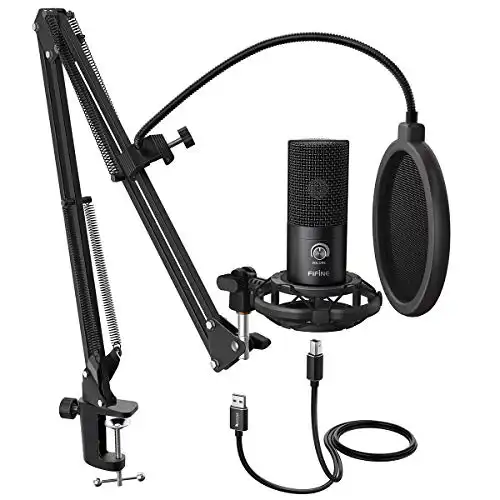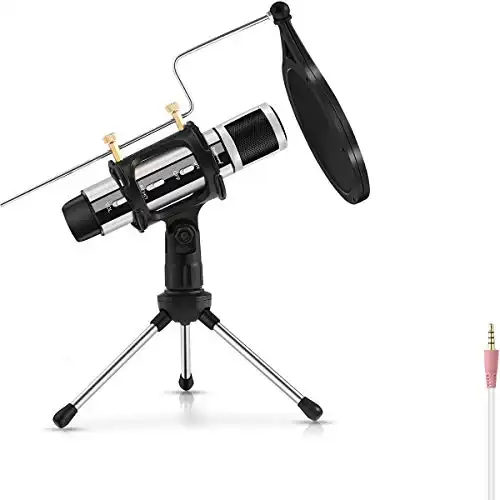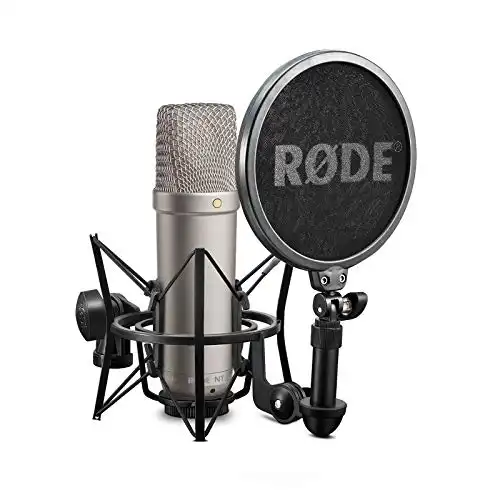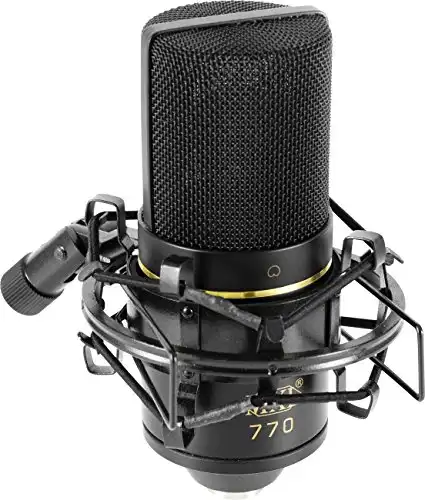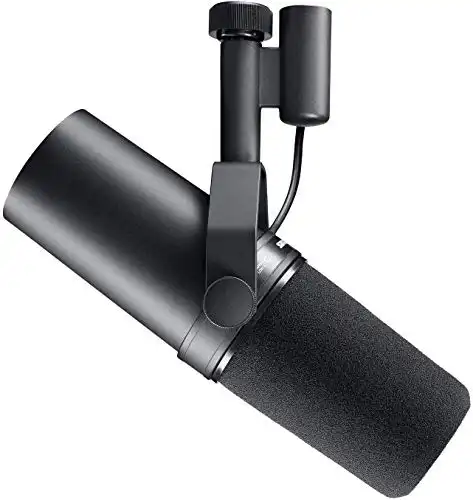When it comes to recording vocals, there is one piece of essential equipment every podcaster needs—a good quality microphone.
Exact, concise words with smooth, conversational tones are much more appealing to your audience’s ears.
Give them vocals with electrical interference, crackling silent spaces, or that rise and fall in tone, and they’ll soon be switching off.
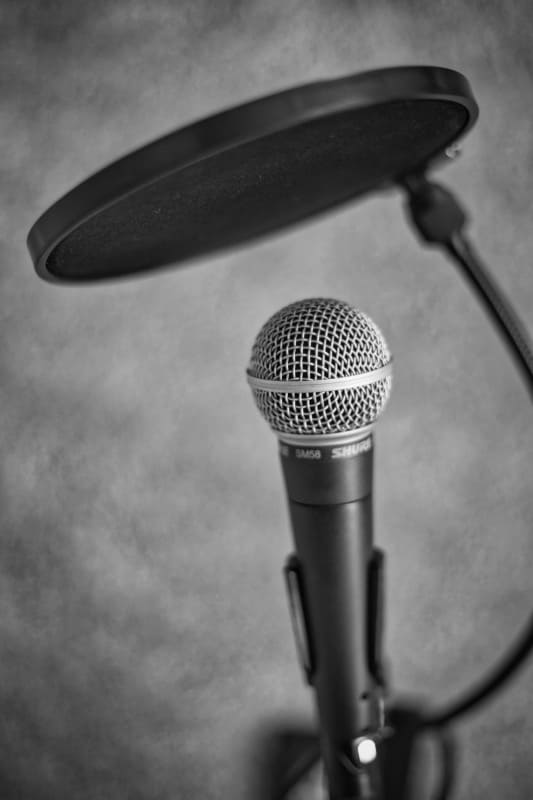
So, how can you make sure that the vocals you’re producing are as clean as possible?
We’re here to save the day! Below, we’ve compiled a list of some of the very best studio microphones for recording vocals. Each of these is guaranteed to pick up every tone and detail of your voice and help you create some high-quality audio.
We’ve also put together a super useful buying guide packed with information on what to keep in mind when you’re shopping for studio microphones.
Table of Contents
1. FIFINE Studio Condenser Microphone
Super easy to set up with a simple USB connection, this Studio Condenser Microphone from FIFINE is a fantastic piece of recording equipment. It even includes an arm stand to help keep the microphone securely held in front of you whilst you’re speaking.
The cardioid pickup pattern allows the microphone to work across a 180º arc directly in front of it.
The pickup pattern means it will concentrate solely on your voice and dramatically reduces any ambient sounds from entering the mic, giving you clear, crisp, concise vocals every time.
It also has a large diaphragm that can pick up a wide range of frequencies and produce them as easy-listening, conversational tones.
There’s a built-in volume control dial located on the microphone, which allows you to adjust your levels as required.
You can use this microphone universally across different operating systems, including Windows and Mac, so you won’t have to change it for another if you fancy a computer upgrade.
It also includes a pop filter that can be placed in front of the mic to prevent the plosives that come from particular words and a two-year warranty.
See the Latest Pricing on Amazon
Pros:
- Quick and easy to set up with a simple USB connection
- Uses a cardioid pickup pattern and wide frequency range to produce high-quality vocals
- The built-in volume control dials allow you to adjust your sound levels directly from the mic
- Can be used universally across different operating systems
- Comes complete with an arm stand, tripod stand, pop filter, and two-year warranty
Cons:
- The arms stand can be a little tricky to assemble but is a fantastic accessory once built
2. ZealSound Studio Condenser Microphone
This Studio Condenser Microphone from ZealSound operates with an omnidirectional pickup pattern, recording sound from all directions whilst simultaneously concentrating solely on vocals. This makes it a great choice for a podcast with multiple hosts or guests.
It also features a built-in sound card that allows you to adjust your levels as your record through the echo-slide and volume controls.
This microphone has CVC Noise Reduction Technology that further eliminates background noise and ensures the recorded vocals are as clear as possible.
The microphone is easy to set up and uses a 3.5mm jack to create a secure connection to your recording device.
There is a built-in headphone jack on the microphone too that allows you to monitor your vocals, giving you the ability to adjust your levels as you record and taking a lot of work out of the editing process.
Available in three different colors to suit any studio set up, and its aluminum construction makes it highly durable without being weighty.
It also comes complete with a tripod stand, pop filter, all of the cables needed to set it up, and is backed by a hassle-free money-back guarantee.
See the Latest Pricing on Amazon
Pros:
- Records with an omnidirectional pickup pattern that records from all directions while concentrating solely on vocals
- Features a built-in sound card that allows you to adjust your levels while you record
- Also features CVC Noise Reduction Technology that brings extra clarity to vocals
- Easy to set up through a 3.5mm jack, and features a headphone jack for low-latency vocal monitoring
- Available in three colors and includes a tripod stand, pop filter, and all the necessary cables
Cons:
- The wires are relatively short, which may restrict the way you’re able to arrange your studio
3. Rode NT1-A-MP Studio Microphone
Featuring a large 1-inch capsule and a gold plated diaphragm that covers a wide frequency range, the NT1-A-MP Studio Microphone from
This is further enhanced by the cardioid pickup pattern that concentrates on your voice and nothing else, eliminating unwanted background noise.
It operates with a self-noise level of just 5dB, too, making it one of the quietest microphones available and meaning that there’s never any risk of it intruding on the vocals you’re recording.
Built-in internal shock-mounting prevents it from picking up any random noises such as table bumps or reverberating noise coming from bare walls.
It also includes a uniquely designed stand to keep it securely held in place while you record and a pop filter to prevent any plosives on your recording.
The nickel-plated body makes it both lightweight and durable, so it can be taken from place to place without weighing your bag down or getting damaged.
It’s an aesthetically pleasing microphone that is guaranteed to add a splash of style to your studio and give it that professional look.
See the Latest Pricing on Amazon
Pros:
- Features a 1-inch capsule and large, gold-plated diaphragm that works across a wide frequency range
- The cardioid pickup pattern eliminates ambient noise and focuses the mic solely on your vocals
- Has a self-noise level of just 5dB, making it one of the quietest microphones available
- A built-in shock mount further promotes noise reduction and prevents any accidental noise from being picked up
- Comes with a unique tripod stand, pop filter, and a 10-year warranty
Cons:
- At the higher end of the price spectrum for microphones. However, it’s quality and performance is undeniable, and a generous warranty backs it.
4. MXL 770 Cardioid Condenser Microphone
With a frequency range of 30Hz – 20KHz, the MXL 770 Caridoid Condenser Microphone is capable of recording high-quality vocals across a variety of voice types and producing them crystal-clear, smooth clarity.
The cardioid pickup pattern works across a 180º arc directly in front of the microphone and prevents it from picking up any unwanted ambient noise.
This means it allows it to focus solely on your voice and record your vocals without directing attention elsewhere.
An included shock mount serves multiple purposes. Firstly, it acts as a stand and helps keep the microphone securely held in position while you’re recording, giving you more freedom to move and gesticulate.
Secondly, it prevents any accidental unwanted noise, such as table-bumps, from being picked up.
It’s compact and lightweight as well, which makes it easier to transport should you wish to take your show on the road.
It also comes with a heavy-duty storage case, a pop filter to help prevent plosives when recording, and is backed by a 12-month warranty.
See the Latest Pricing on Amazon
Pros:
- Has a frequency range of 30Hz – 20KHz that can pick up a variety of vocal tones
- The cardioid pickup pattern concentrates on your vocals and eliminates ambient noise
- An included shock mount acts as a stand and prevents accidental noise from being picked up by the microphone
- Comes with a pop filter to avoid plosives and keep vocal-quality crisp
- Compact, lightweight, and can be transported or stored in the included heavy-duty case
Cons:
- Some people noted that the included shock mount needing re-tightening from time to time
5. Shure SM7 Cardioid Dynamic Microphone
This is what the biggest podcasters in the world use. It's high quality and can take a beating! If you setting up a professional level studio, this mic will fit right in.
Another stand-out product from world-renowned brand Shure, the SM7 Cardioid Dynamic Microphone, has a variety of features that makes it perfect for recording vocals.
The first of these features is a comprehensive frequency response capable of picking up a range of vocal tones and producing superior clarity.
It also features internal ‘air suspension’ shock isolation. Shock isolation eliminates any mechanical noise interference from the microphone itself and works with the cardioid pickup pattern to eradicate background noise.
In turn, this leaves you with nothing but sharp, clear vocals every time.
The built-in pop filter further enhances this microphone’s vocal-recording capabilities by dramatically reducing the risk of plosives or breath sounds.
This mic rejects electrical sound interference by design, such as broadband noise emitted by computer monitors.
A Yoke mounting system and a captive stand are included with this microphone, allowing you to set it up and hold it securely in place effortlessly.
It has a rugged, stylish design and is durable enough to take out on the road without fear of it getting damaged.
See the Latest Pricing on Amazon
Pros:
- Has a wide frequency response range that delivers clear vocals across a variety of voice tones
- Features internal ‘air suspension’ shock isolation that eliminates the pick up of mechanical noises
- The cardioid pickup pattern concentrates on vocals and reduces any background noise
- A built-in pop filter helps to ensure vocals are clear by eliminating plosives and breath sounds
- Includes a Yoke mounting system and a captive stand to keep the microphone in place while recording
Cons:
- This microphone is also slightly higher in price than some others, so isn’t the best choice for anybody on a budget
Buyer’s Guide
There’s no doubt that you need an excellent studio microphone to record high-quality vocals. But what do all the technical terms mean? And how can you be sure you’re choosing the right for your personal podcasting needs?
Don’t panic! Below, we’ll go further into detail and explain some of the technical jargon. We’ve also listed some key points to keep in mind when you’re on the hunt for your microphone, helping to ensure you find the correct one the first time around.
Connection
The first thing you need to think about is what sort of connection type your current recording equipment will support. Some have USB ports, others have XLR ports, and some even have a mix of both.
It’s relatively easy to work this out. Generally speaking, if you record directly onto a computer, then you’ll likely need a microphone that has a USB connection. If you use an audio interface or mixer, you’ll probably need an XLR connection.
If you use a computer for recording, you’ll also need to check that your chosen microphone is compatible with your operating system. Most are universally compatible with Windows, Mac, and Linux.
However, some will only work with specific systems, so it’s something worth checking before you purchase.
Pickup Pattern
The pickup pattern is a technical term that you’ll see written in the specification of all microphones.
The type of pickup pattern your microphone uses will ultimately dictate what noise it picks up, so it’s an important thing to look at when you’re recording vocals.
To get great vocal-quality, you should look for a microphone that records with a cardioid pickup pattern. It allows the microphone to record across a 180º arc directly in front of it and eliminates any ambient noise.
It will leave you with a recording that has been focused solely on your voice and won’t have any bizarre noises in the background. It’ll also save you a lot of time in the editing process.
Some microphones use omnidirectional pickup patterns, and these work by recording sound coming from all directions.
While they aren’t ideal for solo recording, they could be the right choice for a podcast with multiple hosts or guests were sharing a microphone may be necessary.
Frequency Response
The frequency response your microphone has will play a significant role in its ability to pick up different vocal tones. So, it is an excellent thing to look out for if you have a new guest on your podcast every week as no two voices are ever the same.
The broader the frequency response, the greater the variety of vocal tones your microphone will be able to pick up.
Look for something that has a range of between 30Hz – 50KHz. This frequency range will allow the microphone to record across various voice types and produce them as smooth, conversational tones.
Level Adjustments
Some microphones offer you the ability to monitor your vocal levels while you’re recording through a built-in headphone jack. This means that you can adjust your levels as you speak, and takes a lot of work out of the editing process.
A microphone that features a volume control dial will also allow you to adjust your levels directly from the microphone, so you won’t have to worry about quickly finding the correct slider on your recording equipment to make your adjustments.
A mute button is another great feature to look for on a microphone. Having this button will allow you to speak aloud without the microphone picking anything up at all. Perfect for those moments when gesticulating to your co-host or guest just isn’t working!
Extra Features
It’s always worth seeing what else you can get for your money, and lots of microphones come with extra features and accessories that won’t just give you more bang for your buck, but will also help produce even better vocals.
The best of these is a pop filter. A pop filter works by creating a shield between your voice and the microphone and eliminating any plosives or breath sounds that naturally happen when you’re speaking.
Any microphones that include a stand (arm stand, desk tripod stand, etc.) are an excellent thing to look out for too. It will keep the microphone steadily in place for you throughout the recording session.
A stand will also leave your hands free to adjust your levels or make your way through your interview notes.
Shock absorption is also an excellent extra feature to look for. It works by absorbing any vibrations or random noises that might occur when you’re recording, such as table-bumping or echoes reverberating from bare walls and floors.
Price
Finally, you’ll notice that microphones can vary quite dramatically in price. We’d recommend setting yourself a budget before you start shopping and trying to stick to it as much as possible.
Some less expensive microphones have just as many features as those with better-known brand names, so it’s worth doing the research and seeing what you can get for your money.
Frequently Asked Questions
What are plosives?
Plosives are the natural ‘popping’ sounds from the pronunciation of individual letters such as ‘p,’ ‘k,’ ‘d,’ and ‘g.’ A microphone that includes a pop filter will eliminate these sounds from being picked up and leave your vocals sounding smooth and seamless.
What is the best microphone for recording vocals?
A microphone that operates with a cardioid pickup pattern is best for recording vocals. A cardioid pickup will only record sounds coming from directly in front of the microphone and eliminate background noise.
